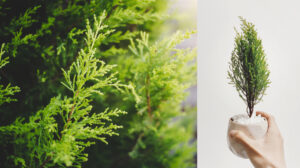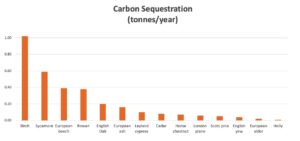The 21st of March was the International Day of Forests, so we planted over 350 trees in North Yorkshire to offset our family’s carbon footprint. The trees will form a beautiful hedgerow along a 200 meter boundary edge of our sustainable building project at Holmefield. The hedge provides sustainable and sympathetic protection from the wicked winds that can blow across the fields, as well as noise protection and privacy. In addition, it will provide ecological benefits to living things that depend on hedges for habitat, food, and protection from predators.
As many of you following the Ecodove journey will know, we have been working on an ambitious project to convert two derelict barns in North Yorkshire to a sustainable dwelling. Unfortunately our permitted development application was refused by the local council and is currently under appeal. One of the objections was that there was not enough screening present on the site to provide privacy for our neighbors.

Planting a hedgerow presents us with a great opportunity to address this concern and also offset our carbon footprint. After much investigation, we decided to pursue a natural hedge of Leyland Cypress. This will provide the site with natural protection from wind and sound, and also provide a beautiful privacy screen. It is also 30% less expensive than putting in a wooden fence and is better suited to stand up to the harsh winds that are common to the property which sits on a hilltop close to the sea. In contrast to timber fencing, the Leylandii hedge will absorb carbon dioxide, offsetting the carbon footprint of our family through carbon sequestration.

Carbon Sequestration
Carbon sequestration refers to a natural or artificial process by which carbon dioxide is removed from the atmosphere. Tree planting is a simple and natural way to remove carbon dioxide from the environment, as trees absorb carbon dioxide as part of the photosynthesis process. They use carbon dioxide, water, and sunlight to make sugars to feed themselves. As a by-product of that process, oxygen is released into the environment.
Leyland Cypress are estimated to sequester 120kg of carbon a year. We planted 379 trees, giving an annual sequestration estimate of just over 45 tonnes of carbon a year. Our family carbon footprint is estimated to be between 35 and 50 tonnes per year, so we are so thrilled that our planting of a lovely natural hedge at Holmefield will almost entirely offset our family’s personal carbon footprint.

source: itreetools.org
Hedgerows as Ecosystems
According to the RSPB, hedgerows support a number of species in the UK. They may support up to 80 per cent of woodland birds, 50 per cent of mammals and 30 per cent of butterflies.
“In areas with few woods, many species of birds depend on hedgerows for their survival. At least 30 species nest in hedgerows. Many of these, such as bullfinches and turtle doves, prefer hedgerows more than 4m tall, with lots of trees; whereas, whitethroats, linnets and yellowhammers favour shorter hedgerows (2–3m) with fewer trees. Dunnocks, lesser whitethroats and willow warblers prefer medium or tall hedgerows with few trees.
Wrens, robins, dunnocks and whitethroats usually nest low down, but song thrushes, blackbirds, chaffinches and greenfinches nest well above the ground level. Grey partridges use grass cover at the hedge bottom to nest. It is therefore very important to manage for a range of hedge heights and tree densities and to maintain a grassy verge at the base of the hedge.
Grassy hedge bottoms and field margins provide nesting material and insect larvae for chicks to feed on. Wild flowers and grasses growing up into a hedge also help to conceal nests from predators. In winter, hedgerows can be feeding and roosting sites for resident birds and winter visitors such as fieldfares and redwings.”
According to the Woodland Trust:
“There are 130 Biodiversity Action Plan species closely associated with hedges including lichens, fungi and reptiles. Many more use them for food and shelter during some of their lifecycle. Bank vole, harvest mouse and hedgehog all nest and feed in hedgerows alongside birds including blue tit, yellowhammer and whitethroat, while bats use them as ‘commuter routes’ for foraging and roosting.
As well as providing food and shelter, hedges help species to move through our landscapes from one habitat patch to another. These wildlife corridors are vital for species like the rare hazel dormouse which struggle to cross large open areas like farmed fields.”
Have you got space for trees?
If you are considering fencing to protect your garden or pastures from weather, noise, or simply to give yourself a bit of privacy, consider a hedgerow as an alternative. Yes, trees in a hedgerow can take time to grow, but they last longer than most timber fences and cost less to install if you are willing to plant small and be patient.
Even if your garden is not well suited for a hedge, it is worth consideration if you have space for even a few trees. Planting just a few birch, sycamore, or oak trees in your back garden can have a big impact. Here in the UK, the Woodland Trust provides support for landowners looking to plant trees on their own land and resources and free trees to people looking to plant via a school or within their local communities. There are also grants available from the UK government.
Even if you have a black thumb (like I do), there are lots of ways to get involved that don’t involve unsupervised planting in your own garden. My son’s school has planted hundreds of trees this year along the edge of the school’s playing fields – with parents and students coming together to dig holes and plant seedlings. Even my mediocre gardening talents were put to good use under strict supervision as we planted 100 trees in an afternoon. You can support tree-planting organizations with a donation of time or money: 1 trillion trees in the US, Trees for Cities UK, and Trees for the Future both accept donations. See the Resources section below for more information and links to additional organizations that are working to plant trees.
Resources:
UK Gov Tree Planting Initiatives
Best Tree Planting Charities (Impactful Ninja)
Non-Profit Point Top 10 Tree Planting Charities